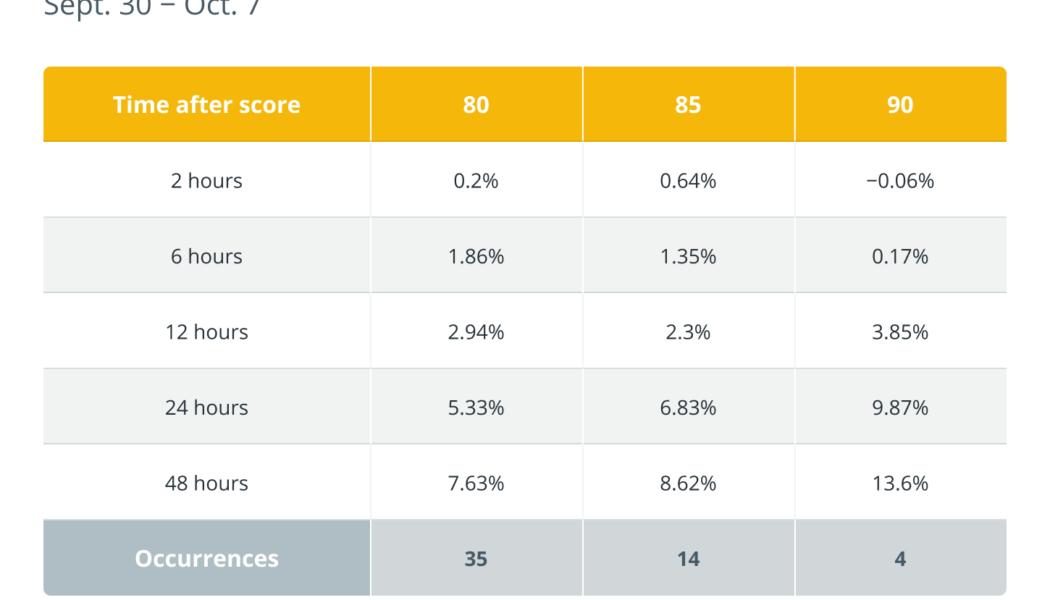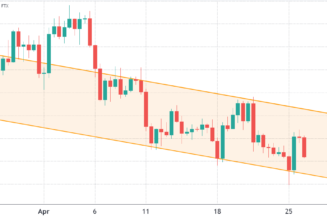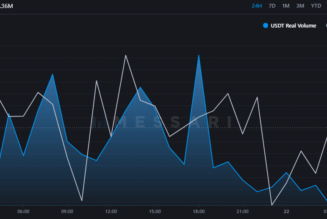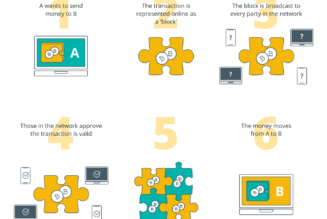It might seem that the volatility of digital assets’ prices and the lightning speed with which crypto markets move would mean that those who act fastest secure the heftiest rewards.
And in certain cases this holds true – for example, when an announcement of a token’s listing on Coinbase or Binance first goes public, and the asset’s price line becomes all but vertical.
But in many cases, the tortoise beats the hare.
This principle is clearly at work when it comes to traders using quant-style tools to enhance their decision-making. One example is the VORTECS™ Score, an algorithmic comparison between historic and present patterns of market and social activity around a coin.
While the VORTECS™ algorithm is trained to detect historically bullish conditions around crypto assets, high scores are rarely followed by price surges immediately. In fact, the highest returns consistently arrive over the next few days after peak scores show up. What does it reveal about the nature of the crypto market?
The early bird gets the worm (but waits to eat it)
Exclusively available to the subscribers of Cointelegraph Markets Pro, the VORTECS™ Score is an artificial intelligence-powered indicator that looks for historic similarities across a multi-dimensional set of variables. These include changes in the price of a crypto asset, trading volume, social sentiment, and tweet volume, among others.
The higher the VORTECS™ Score, the more confident the model is that the observed combination of the key metrics around the token resembles past conditions that foreshadowed significant price hikes. Scores above 80 are considered confidently bullish, while a rarer sight of a 90+ Score suggests that the asset’s outlook is tremendously favorable, judging by its historic record of price action.
The timing, however, is intentionally fuzzy as the model is designed to detect conditions that had previously preceded rallies by 12 to 72 hours. In fact, although the algorithm is designed to flag bullish conditions as early as possible, it consistently delivers best results to crypto traders within days, rather than hours.
Historical data show that, on average, assets that score high on the VORTECS™ Score deliver consistent if small returns as soon as six hours after reaching the Scores of 80, 85, and 90.
Thus, crypto investors who rely on Markets Pro data to refine their trading strategies are often tempted to lock in profits early. The same data, however, suggest that it often makes sense to hold steady rather than grab the initial gains.
HODL, if only for a day or two?
The table below presents average returns after a crypto asset cleared a score of 80, 85, or 90 over a week. Each asset could only yield one observation per day, i.e. if a coin went from 79 to 81, then back to 79 and then to 80 once again in a few hours, only its first entry to 80+ would count.

As visible in the table, the more time passes after assets clear the threshold of 80, 85, or 90 VORTECS™ Score, the more likely they are to deliver larger returns. While these stats only reflect price movement from a single week, the pattern is actually observed very consistently throughout Markets Pro history dating back to early 2021.
In fact, 48 hours is not the limit. When it comes to ultra-high scores above 90, some Markets Pro subscribers report generating consistently large gains from holding such coins for a full week, or 168 hours.
These observations suggest that the crypto market could be not as chaotic and whimsical as many believe. Although many moves are clearly driven by waves of FUD and hype, the wider marketplace of digital assets exhibits identifiable regularities and recurring patterns of trading and social activities that can take days and weeks to build up before they move asset prices.
Cointelegraph Markets Pro’s VORTECS™ Score is simply one way to identify the conditions that lead to these moves — as early as possible. It’s up to the individual trader to decide when to take the profits.
Cointelegraph Markets Pro is available exclusively to members on a monthly basis at $99 per month, or annually with two free months included. It carries a 14-day money-back policy, to ensure that it fits the crypto trading and investing research needs of subscribers, and members can cancel anytime.
Cointelegraph is a publisher of financial information, not an investment adviser. We do not provide personalized or individualized investment advice. Cryptocurrencies are volatile investments and carry significant risk including the risk of permanent and total loss. Past performance is not indicative of future results. Figures and charts are correct at the time of writing or as otherwise specified. Live-tested strategies are not recommendations. Consult your financial advisor before making financial decisions.










